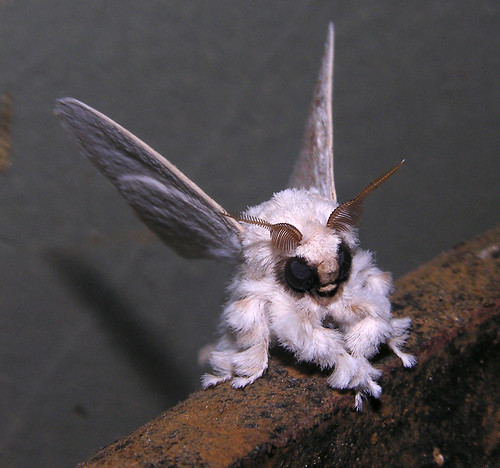A few months ago many of you probably stumbled across this meme – the famous Poodle Moth! And indeed for the most part the reporting was half decent. Yes, it’s real. Yes, it’s a moth. Yes, it’s probably a species in the Lasiocampidae (possibly the genus Artace) as correctly pointed out by Dr. John Rawlins.
I expected this to be all well and good, hey there are tons of cute moths out there and it’s about time someone noticed! I didn’t bother to read the article until a colleague forwarded it to me from the “Cosmic Log on nbcnews.com“. What I found was horrifying hilarious. NBC for some reason decided to cite a cryptozoologist who was one of the first people to apparently blog about this moth and attempt to identify it (incorrectly, but not a bad effort for a non-entomologist). And then stories like this one in the Christian Post started popping up everywhere: Venezuelan Poodle Moth Confuses Scientists. For some reason they all love using lines like “mystifying researchers”, or “baffling scientists”. I’m always amused by the catch words used in stories like this – and don’t really understand why they are so popular. I guess every time a scientist says “boy this is interesting” it gets misinterpreted as them being baffled; which makes me think the reporter might enjoy knocking science off of its imaginary ivory tower when they get to say “hey look these stupid scientists don’t even know the answer”. And while we often don’t know the answer (it’s sort of our job to discover those answers), it doesn’t mean we’re stumped. Especially in this case, it’s just a fluffy moth.
No real harm, but that whole cryptozoology thing gets me riled up. I think its unfortunate that a cryptozoologist nabbed so much publicity and was talked about with a fair amount of credibility.
Cryptozoology is not a science, nor will it ever be. When cryptozoology is conducted as a science it’s called biology.
Yes there are nuts out there who believe they are conducting real science, following tall tales in circles and building stacks of anecdotal “evidence” that never seem to result in truths. There are real differences between what a scientist and a pseudoscientist does. Say a scientist hears reports of an odd animal living in the deep jungles – they embark on an expedition (after begging for funding) to do the hard work of piecing together local stories and trekking the jungles or diving the oceans to find the specimens. Then they bring those specimens home, dissect every detail, and publish the results in a peer reviewed journal. If no specimens were found then that scientist goes home empty handed and rethinks the possibility of this new mythical creature. Maybe more funding would give them more time in the field… (always the answer, right?) But the story ends there, without evidence the animal doesn’t exist. This is where cryptozoology departs from real science – they embrace anecdotal tales as fact and never admit defeat. Nessy exists because people see him. The explanation can’t possibly be any large array of more plausible options… because the world a cryptozoologist lives in is mythical and fundamentally not real.
OK enough ranting, let’s just hope for more adorable moths hitting the news cycle!


















